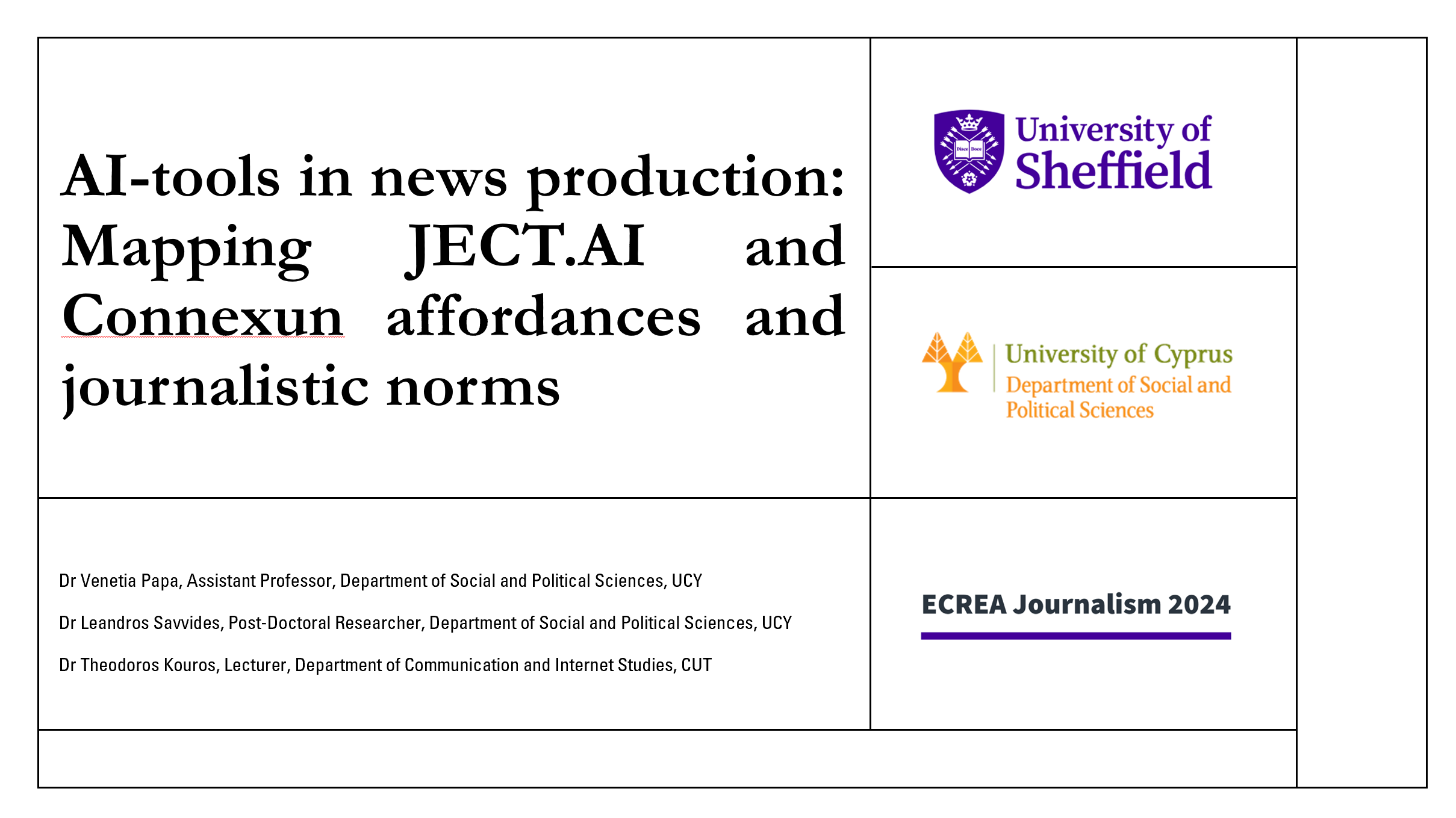Datact lab member Dr. Leandros Savvides participated in the 2024 ECREA Journalism Studies Conference. The conference was hosted by Dr. Lada T. Price and her team at the School of Journalism, Media & Communication, University of Sheffield, UK, and took place between 11-12 April 2024.
The core theme of the conference was Diversity, Equality, and Inclusion in and through Journalism, and it aimed at bringing together scholars reflecting on the role, nature, state, management, and challenges regarding diversity, equality, and inclusion within journalism itself and in society through journalism.
Our paper “Can AI-tools help journalists or replace them? Exploring the relationship between affordances of JECTAI and Connexun and journalistic norms” was presented in the very first panel along with other interesting and valuable works on developments and integration of AI in newsrooms and journalism as a profession
Read the abstract
On October 8, 2023, we asked GPT-3 a question regarding how journalists utilize artificial intelligence. In response, GPT-3 provided insights on the various ways AI benefits journalists by enhancing their work, streamlining processes, and improving the quality of their reporting. These AI applications include data analysis, content generation, curation, predictive analytics, social media monitoring, fact-checking, and verification (Chat GPT3, 2023). Subsequently, we inquired about the specific AI tools employed by journalists. The AI mentioned that tools like GPT-3 and its variants are used for automated content generation, including news articles, summaries, and reports. Journalists can input data or key information, and the AI assists in rapidly generating written content (Chat GPT3, 2023). Departing from this statement, our study engages in a sociotechnical analysis of two AI tools (along with their training for journalists) to understand the material means by which these tools strive to engage journalists vis-à-vis their business models.
This manuscript is a response to the recent call of Lopez-Guttierez et.al (2023) that is only through uncovering the complex role of AI newsroom technologies that we can unpack their meaning in complex socio-technical environments. A sociotechnical perspective can allow the exploration of their potential for supporting but also undermining journalists’ work. Thus, it can offer both an understanding of AI tools but also help uncover the potential of blending algorithms and journalists’ expertise. We understand such a blend as a necessity of news industry outlets to increase productivity whilst also increasing or at least withstand validity claims and integrity of news produced, in order to remain competitive. This study is inscribed within the continuum of a previous study where Google News Initiative and Facebook Journalism Project (Papa & Kouros,2023) were identified as initiators of a form of platform schooling which, in addition to journalism schools and work environments, mediates understandings of what is and what is not proper behavior when practicing journalism.
Through affordance theory, we argue that interfaces of technological artifacts are manifestations of their material conditions, implicit politics and ideology, given that affordances entail normative claims about what users should do. Our study is based on two AI journalistic tools, the JECTAI and Connexun. JECT.AI is a research-based tool developed to enhance journalists’ capabilities by automating the process of uncovering creative content perspective, angles, and voices for new articles. It functions as a co-creative AI tool, harnessing machine intelligence to enrich human creative thought processes. To achieve this, it combines natural language processing, multi-language creative search, and interactive creativity guidance. Its primary function is to extract information from published news articles and assist journalists in forging innovative connections with this data during their creative ideation processes (Maiden et.al, 2023). Connexun is a platform marketed as a versatile service to help news organizations harness online information effectively and increase productivity. It uses proprietary versions of Natural Language Processing (NLP) to engage in supervised and unsupervised learning enhanced by deep learning. This service covers multiple key areas. Real-Time News Tracking is a core function, suggesting “fast and accurate monitoring of over 20,000 trusted sources”, ensuring a real-time view of online media coverage. The platform implies that it is a valuable platform for journalists catering to the discerning needs of journalists by providing an extensive array of tools powered by NLP and real-time data. AI-Driven Media Intelligence goes beyond basic monitoring, using predictive AI to identify relevant web topics and trends, offering data-driven insights. Based on the premise that ‘the interface of a computing technology is the manifestation of its implicit politics and ideology’ (Sun & Hart-Davidson, 2014, p. 3534), affordances entail normative claims ‘about what Users should do’ (Stanfill, 2015,p. 1062) in our case journalists.
Our study draws from JECT.ai and Connexun to explore how the affordances of these AI tools allow particular behaviors and encourage while challenging certain journalistic norms to emerge. Regarding the method of analysis, we proceeded in three steps. First, we studied all texts related to the projects’ websites (descriptions, instructions of use, available tools, etc.) and other sources linked to by their websites (e.g. media articles) to get a sense of the projects’ philosophy. Second, to explore the affordances of each project, we performed a discursive interface analysis of the selected cases. We argue that both AI tools affordances can facilitate and at the same challenge a form of platform schooling which, in addition to journalism schools and work environments, can might dictate what is and what is not “successful journalism”, initiating a form of AI-assisted reporting.
